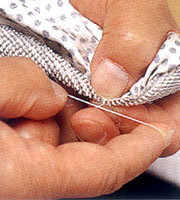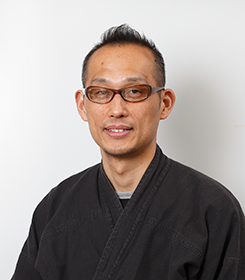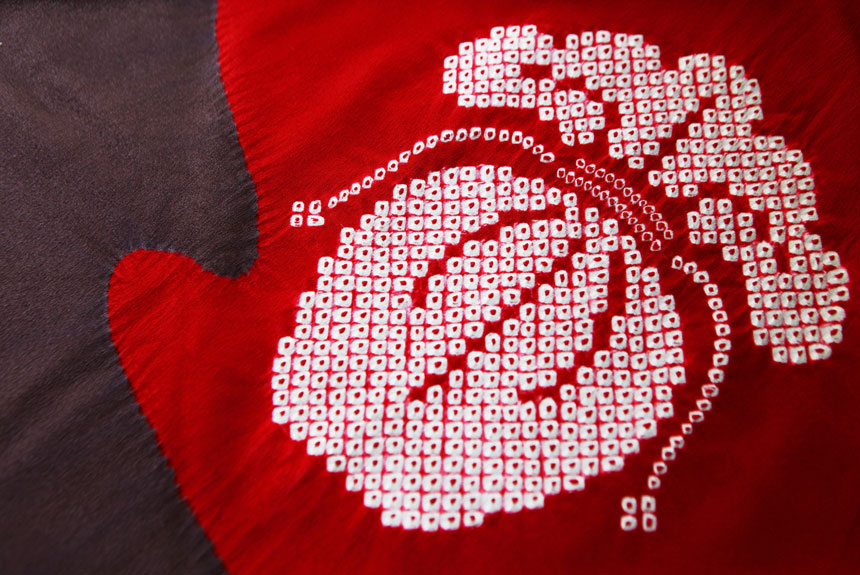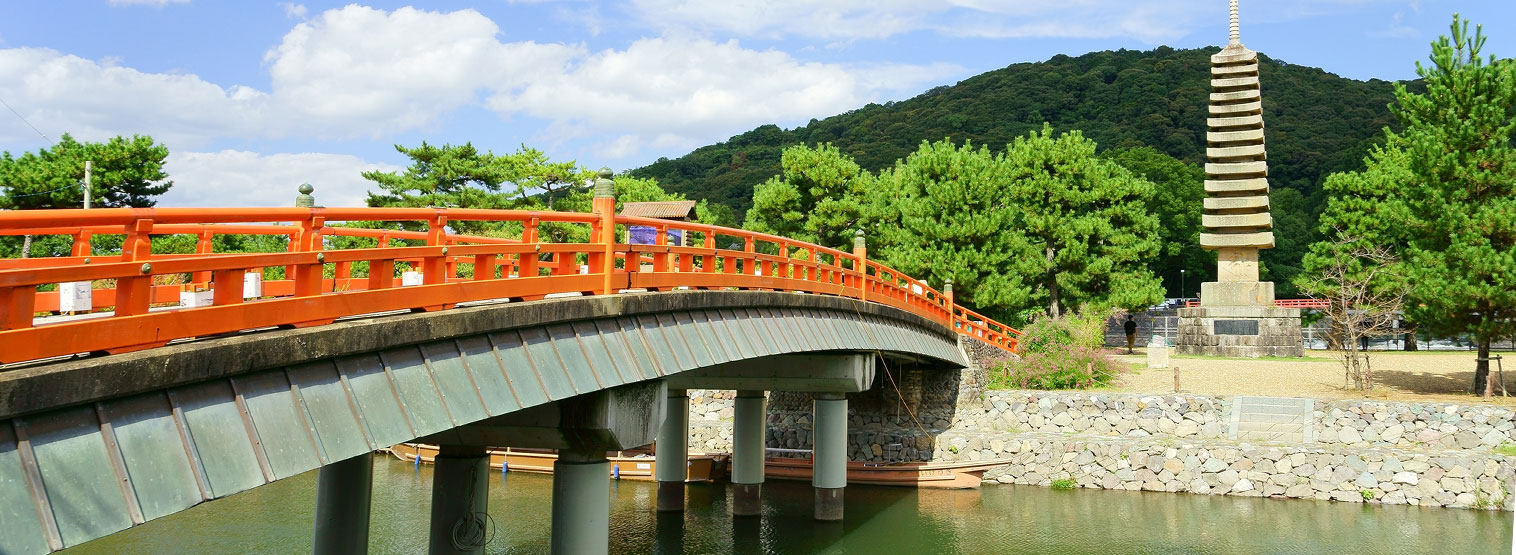1.What is Kyokanoko shibori ?

“Shibori(絞り:Aperture)” dyeing has been practiced in Japan for more than a 1000 years and has been used as a pattern expression for costumes.
It is called “Kanoko shibori(鹿の子絞)” because the pattern of “the bundling(括り:kukuri)” resembles the spots of a fawn.
Among the tie-dyeing, “Hitta shibori(疋田絞り:Hitta squeezing)” and “Hitome shibori(一目絞り:Hitome squeezing)”, which are said to be “Kanoko(鹿の子:Deer child)”, have other details such as the precision of the squeezed grains and the unique three-dimensional effect of squeezing. It is unique.
In addition, the patterns are expressed by combining the expressive power of each binding technique.
Depending on the item, it takes more days from design decision to completion than ordinary dyeing.
When it comes to “Furisode(振袖), a daunting number of 180,000 to 200,000 grains is made.
Even if you are an expert, it is best to pack 800 to 1,200 grains a day.
When it comes to “Furisode(振袖:Long sleeve kimono)”, it takes a year and a half from the design decision to the finish.
It is not uncommon for Furisode to be more than two years old.
The beautifully tied “So Hitta shibori” is dyed and the grains of uniform size are lined up accurately at an angle of 45 °.
It’s extremely precise, but not as perfect as mechanical work.
The faint blurring that cannot be measured creates the warmth and expression unique to handicrafts.
Here is the beauty that can only be created from human hands.
History
From the Muromachi period to the early Edo period, “Tsujigahana(辻が花)” became popular as flower dyeing, and in the middle of the Edo period, the heyday of Kanoko shibori was reached.
Even after that, the skill of the minions has been steadily inherited..
Main products
Kimono fabric, Fried obi, Western clothing, Upholstery
Raw materials
①As for the fabric, silk fabrics are used for the designated products , but other fabrics such as hemp cotton are also used.
②The binding thread shall be silk thread, cotton thread or linen thread.
Technique
①In the sketch, using a blue flower like that
②The binding should be one of the following
1. Hitta Shibori:
Pinch with the toes of your fingers, fold it in four, wind it 3 to 7 times, and then tighten it.
2. Hitome shibori:
Pinch with the toes of your fingers, fold it in four, and tighten it twice.
3. Kasamaki shibori (傘巻絞:Umbrella winding squeezing):
Tightening by flat stitching and then “rolling up”
4. Boushi shibori(帽子絞:Hat squeezing):
After tightening by flat stitching, “wrapping” and “rolling up” the resist dyed part.
5. Tatejime shibori(縦締絞:vertical squeezing):
By flat stitching, folding stitching or winding stitching. In this case, tighten the binding part evenly.
6. Utajime(唄締):
“winding up” and “unwinding” using a “Utajime stand(唄締台:Workbench)”.
7. Hari hitta shibori(針疋田絞:Needle hitta squeezing):
Using a needle Harihitta shibori stand(針疋田絞台:Workbench)”, wind the bobbin 3 times or more and 7 times or less, and then tighten it.
8. Hari ichimoku shibori(針一目絞:Needle ichimoku squeezing):
Tightening twice using a “Hari ichimoku shibori stand(針一目絞台:Workbench)”.
③When “Somewake(染め分け:dying separately)”, do one of the following
1. Oke shibori(桶絞:Tub squeezing):
After tightening by flat stitching, the resist dyeing part is sealed in the tub and dyed.
2. Itajime shibori(板締絞:Stencil squeezing):
Stencils are sandwiched between folded fabrics, both ends are fixed, and then dyeing is performed.
④The dyeing method is manual dyeing.
2.Working process
①Composition・design:
The composition and design are decided by the manufacturing wholesaler and the painter.
The painter draws a sketch so that the length and body will be designed according to the composition.
②Shitae katahori(下絵型彫:Sketch engraving)
Based on the design, the iris sketch is made by engraving a small circle or thin line on the paper pattern.
③Shitae surikomi(下絵刷込:Imprinting sketch)
Remove the paper pattern and brush the sketch on the fabric.
This sketch has a mechanism to understand what kind of technique is used to tie it with holes and lines in the pattern, and it gives instructions on processing technology.
In some cases, it is hand-painted without using a paper pattern.
④ Sibori kukuri(絞括:Squeezing)

“Hitta Shibori” is a typical example of Kyokanoko shibori, and is generally called “Kanoko shibori”.
With the technique of tying with only the fingertips and silk thread, each squeeze is tied with silk thread 3 to 7 times to form a single pattern as a set of small squeezed patterns.
Of all the squeezing techniques, it requires the most skill and time.
In addition, there are more than 50 types of squeezing techniques such as Hitome shibori, Nuishime shibori, and Kasamaki shibori, and there are specialized technical craftsmen for each technique, Engaged in stuffing.
⑤ Bleaching
Bleach the blue and white flowers (青花:Aobana) and other stains on the fabric.
⑥ Dyeing



Since the dyeing method is dyeing, we perform “dyeing” as many as the number of colors to be dyed.
The resist dyeing methods are roughly divided into “Oke shibori” and “Boushi shibori”.
Oke shibori is resist printing part on the inside of a dedicated tree tub of sealing the put wood tub, dyed only part of colors out on the edge of the tub, is a technique that dipped into the liquor as it is.
Boushi shibori is a technique in which the resist dyeing part is covered with bamboo skin (vinyl in recent years), and the thread is wrapped tightly to increase the resist dyeing power and dye.
⑦ Dyeing

Since only one color can be dyed at one time, when dyeing with multiple colors, “dyeing” is repeated for the number of colors.
Since tie-dyeing dyes a product that has undergone a special resist dyeing process called “tie-up”, the “dyeing” method is used, in which the fabric is directly dipped in a dyeing solution.
⑧ Yunoshi finish
Steam is applied to remove unnecessary wrinkles by hand, and the width is removed.
We will make the best use of the texture of the aperture.
3.Traditional craftsman
Teruichi Matsuoka (Dyeing Division)

※Photo: See New Kyoto
写真:あたらしき京都参照
“ The gagô(雅号)” is Kisen(輝染).
Born in Kyoto in 1968.
As the third generation of “Kyoto Shibori Mikyo Co., Ltd.”, we manufacture and produce “Kyokanoko shibori” and Kyoto kimono .
Founded in 1937 in Kyoto, a town of traditional culture.
In 1959, deep-fried “Matsuoka shibori” noren.
We are aiming to revitalize the kimono industry by expanding the market by applying the technology of Kyokanoko shibori to various products.
Recently, he is enthusiastic about expanding overseas, and in 2016, he announced the new fashion brand “KAZOME”, which is based on tradition and innovation.
We are actively working on the development of new products in order to deliver kimonos made using traditional Japanese technique of tie-dyeing to the world.
Kyokanoko shibori, which has a unique expression, is a very distinctive work in which the fabric itself is soft and the atmosphere is soft, which is not found in other dyed products.
5.Impressions
Unlike the parts-type division of labor, a piece of fabric moves back and forth between these people over a long period of time to completion.
When it becomes complicated, the process of “binding(括り)”, “separate dyeing(染め分け)”, and “dyeing(染め)” is repeated many times.
If you fail to do the work, you will have to pay for the fabric you have accumulated.
The further you go in the process, the more valuable the cloth you work with.
I think it’s very stuffy to work in a situation where failure is not an option.
However, the work created in that ultimate tension is just moving and has no words.
Things that can never be created by one person.
A sense of accomplishment that can never be obtained alone.
I think this “Kyokanoko shibori” is an extremely work that has been packed with countless craftsmen for more than 1000 years.
I definitely want to wear it.
Next time preview
Thank you for reading to the end!
Also, I would like to post some interesting points about Kansai in Japan.
Then, have a good trip from now on!!
PS. We provide various information about Kansai in Japan, so please feel free to contact us if you would like to visit or experience it!



コメント